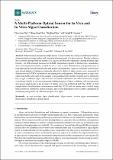| dc.contributor.author | Chen, Qing-Qing | |
| dc.contributor.author | Chua, Jia-Jing | |
| dc.contributor.author | Ng, Chee-Loon | |
| dc.contributor.author | Hemond, Harold F | |
| dc.date.accessioned | 2017-06-28T18:48:13Z | |
| dc.date.available | 2017-06-28T18:48:13Z | |
| dc.date.issued | 2017-04 | |
| dc.date.submitted | 2017-04 | |
| dc.identifier.issn | 1424-8220 | |
| dc.identifier.uri | http://hdl.handle.net/1721.1/110358 | |
| dc.description.abstract | Differentiation among major algal groups is important for the ecological and biogeochemical characterization of water bodies, and for practical management of water resources. It helps to discern the taxonomic groups that are beneficial to aquatic life from the organisms causing harmful algal blooms. An LED-induced fluorescence (LEDIF) instrument capable of fluorescence, absorbance, and scattering measurements; is used for in vivo and in vitro identification and quantification of four algal groups found in freshwater and marine environments. Aqueous solutions of individual and mixed dissolved biological pigments relevant to different algal groups were measured to demonstrate the LEDIF’s capabilities in measuring extracted pigments. Different genera of algae were cultivated and the cell counts of the samples were quantified with a hemacytometer and/or cellometer. Dry weight of different algae cells was also measured to determine the cell counts-to-dry weight correlations. Finally, in vivo measurements of different genus of algae at different cell concentrations and mixed algal group in the presence of humic acid were performed with the LEDIF. A field sample from a local reservoir was measured with the LEDIF and the results were verified using hemacytometer, cellometer, and microscope. The results demonstrated the LEDIF’s capabilities in classifying and quantifying different groups of live algae. | en_US |
| dc.language.iso | en_US | |
| dc.publisher | MDPI AG | en_US |
| dc.relation.isversionof | http://dx.doi.org/10.3390/s17040912 | en_US |
| dc.rights | Creative Commons Attribution 4.0 International License | en_US |
| dc.rights.uri | http://creativecommons.org/licenses/by/4.0/ | en_US |
| dc.source | MDPI | en_US |
| dc.title | A Multi-Platform Optical Sensor for In Vivo and In Vitro Algae Classification | en_US |
| dc.type | Article | en_US |
| dc.identifier.citation | Ng, Chee-Loon; Chen, Qing-Qing; Chua, Jia-Jing and Hemond, Harold. “A Multi-Platform Optical Sensor for In Vivo and In Vitro Algae Classification.” Sensors 17, 4 (April 2017): 912 © 2017 The Authors | en_US |
| dc.contributor.department | Singapore-MIT Alliance in Research and Technology (SMART) | en_US |
| dc.contributor.department | Parsons Laboratory for Environmental Science and Engineering (Massachusetts Institute of Technology) | en_US |
| dc.contributor.mitauthor | Ng, Chee-Loon | |
| dc.contributor.mitauthor | Hemond, Harold F | |
| dc.relation.journal | Sensors | en_US |
| dc.eprint.version | Final published version | en_US |
| dc.type.uri | http://purl.org/eprint/type/JournalArticle | en_US |
| eprint.status | http://purl.org/eprint/status/PeerReviewed | en_US |
| dspace.orderedauthors | Ng, Chee-Loon; Chen, Qing-Qing; Chua, Jia-Jing; Hemond, Harold | en_US |
| dspace.embargo.terms | N | en_US |
| dc.identifier.orcid | https://orcid.org/0000-0003-4984-7870 | |
| mit.license | PUBLISHER_CC | en_US |
